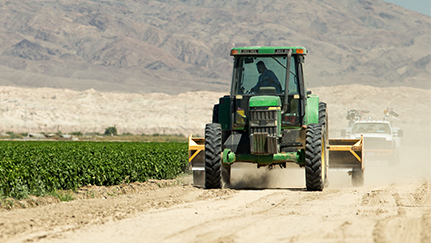It lacks the immediate impact of natural disasters like wildfires and severe storms. But drought can be just as damaging to the landscape and the agricultural families who rely on it for their livelihoods.
And right now, much of the U.S. is in its grip. Safeguard your farm or agribusiness from immediate and long-term drought damage by creating an effective drought plan.
Nothing can replace adequate moisture for crops and livestock. But you can plan ahead and have strategies in place for when conditions deteriorate. Doing so can enable you to lessen drought’s effects on your operation.
“We’re seeing major impacts of drought around the country this year. It’s challenging farmers and ranchers from California to the East Coast,” said Nationwide Agribusiness Senior Consultant Marc Pearson. “Start your drought mitigation planning well before drought conditions develop. It’s the best way to make sure you’re doing everything you can to minimize its effects.”
Create a written drought preparedness plan
It all starts with a written plan. Include input from stakeholders from agronomists to risk management partners. The plan should include:
- Vision statement for your farm or ranch
- Inventory of output, key inputs and other resources like grain or livestock feed
- Key dates like planting and harvest for crops or grazing timeframes for livestock
- How you will monitor key resources
- Outline of strategies for how you’ll respond to drought
“Thinking through the feasibility, impact, and cost/benefit ratio of each potential management option will help you identify the strategies that will work best for your operation,” according to a report from the University of Nebraska National Drought Mitigation Center. “Your list of reasonable options for this year may look completely different from your list of reasonable options for next year.”
How to create a drought plan
In writing your plan, include the best management practices that fit your operation, then answer key questions:
- Does the plan advance work toward my overall goals?
- Is my plan feasible?
- Will it be effective?
- Will the benefits outweigh the costs?
Consider specific tactics in your drought plan
Think about the specific things you can do to prevent excessive drought damage. For example, cattle producers can make plans to use alternative forage and feed sources if pasture output falls short because of drought. Others include:
- Stockpiling forages ahead of livestock feeding needs
- Contact feed suppliers early to ensure adequate supply
- Monitor and build soil health to sustain crop production
- Limit tillage to sustain soil structure and moisture
- Plant continuous cover crops to help soil retain moisture
Finally, consider the cost for those alternative tactics. And review your plan regularly to ensure you’re ready when drought starts eroding your operation’s bottom line.
“You will likely want to re-evaluate your ‘in-drought’ options on an annual basis, at minimum,” according to The National Drought Mitigation Center. “The length of the drought, the severity of the drought, market conditions and other factors have a great impact on what you can do during drought.”
If you’re facing severe drought on your farm or ranch and need help with this planning process, talk to your Nationwide Farm Certified agent today.
